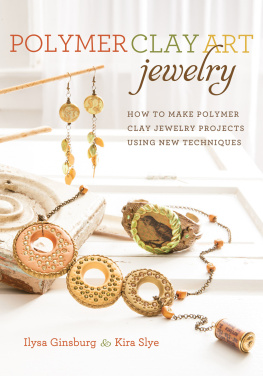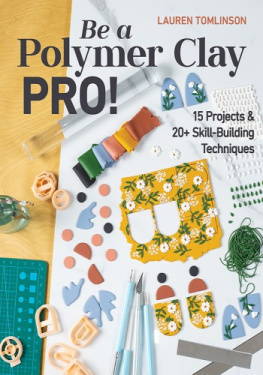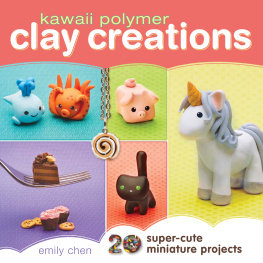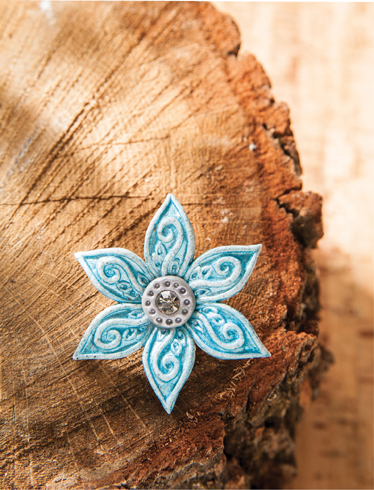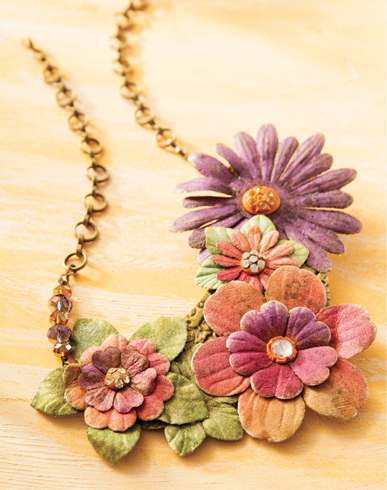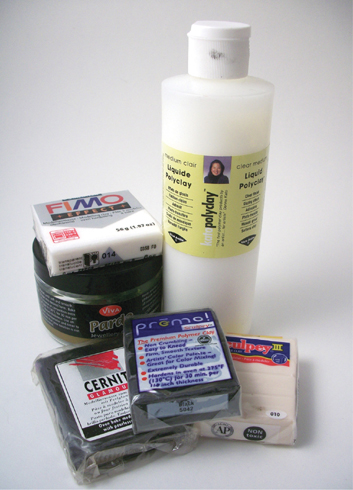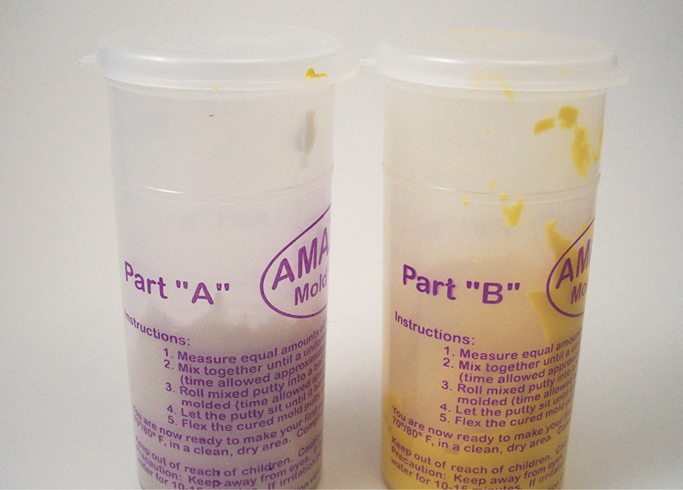POLYMER CLAY
ART JEWELRY
ILYSA GINSBURG AND KIRA SLYE

KP Craft
Cincinnati, Ohio
introduction
Polymer clay has changed our lives. It is difficult to imagine that a medium so simply made from pigment and PVC could have such an impact, but we cant imagine our lives without it. We both discovered polymer clay over twenty years ago on our own personal journeys as artists, and it brought us together with a little help from the magicof the Internet.
In 2006, we opened Etsy shops. By December, Ilysa had found that there were many polymer clay artists on Etsy, but no street team to get them together. She posted a message in the forum for interested shop owners who would like to start a team and build a website, and Kira answered quickly.
After working on the PCAGOE (Polymer Clay Artists Guild of Etsy) together, we discussed putting together a podcast all about polymer clay, and Polymer Clay TV was born. From there came our online community, called CraftyLink.com, where we feature our polymer clay and art teaching videos online in a community classroom setting.
Since our adventure began, we have been around the world and back without ever leaving our homes. Technology has allowed our free demos, project videos and blog into homes in the United States, China, Russia, Africa, France, Spain, Japan and beyond. It always amazes us that people around the globe have shared our journey this way and new people keep finding us all the time.
Our experiences traveling to retreats and conferences, sharing information on blogs and forums, and starting the PCAGOE have taught us that people everywhere want to learn about the art and craft of polymer clay. And we, too, have learned so much along the way. We can honestly say that in all the years we have been creating with polymer clay, we are still learning new things because it is a medium of infinite possibilities.
In this book, we share techniques, tips and tricks we have learned on our journey, many of which are at an intermediate level. We are always looking for new ways to work with polymer clay and the abundant supplies in our art studios. Many of these supplies are not necessarily meant to be used with clay; nonetheless they work very well in our clay designs. We love to try out paints, foils, molds, cutters, papers, glues, fibers and other fun media, and see if we can stick them in, on, or under our clay. We have experimented with items made for jewelry, scrapbooking, knitting, needle arts, cooking, paper crafting. You name it, weve tried it. We cant wait to show you the things we have discovered!
If you are a beginner, you may want to refer to one of the many polymer clay 101 books available to get started, or feel free to visit our instructional podcast located at www.PolymerClayTV.com.
But even if you have never picked up a bar of clay, you should have no problem following the projects in this book. Through step-by-step instruction and detailed photos, we guide you through the different processes and mediums we use to create one-of-a-kind jewelry. We incorporate a myriad of techniques, media and a bit of ingenuity to help you create beautiful finished pieces of art jewelry that you will be proud to wear or to gift.
We hope, too, that the projects in this book inspire you to design and develop polymer clay jewelry pieces of your own. With a medium as interesting and adaptable as polymer clay, you can develop a personal style for your art jewelry.
What are you waiting for? Grab your supplies and a couple bars of clay! Lets get startedwe have a lot to explore.
Ilysa and Kira
materials and tools
The best thing about polymer clay is its extreme versatility. It can imitate many other substances, such as metal, wood, paper, glass and stone. It can be textured, cut, rolled, stretched, knotted, sculpted, molded, knitted, sewn, punched out, extruded, inlaid and embedded. If you can bake it at temperatures up to 275 F (135 C), you can use it with polymer clay.
Therefore, our list of tools and materials is extensive. If it isnt tied or bolted down, we have probably stuck it in our clay. When you say, Everything but the kitchen sink, we say, Why not the kitchen sink? Im sure theres a way to use that, too! We are always finding new tools to add to our repertoire as you will, too. You will never look at a simple thing, such as a pen cap, the same way after seeing the cool impression it makes in the clay. We have discovered many new tools this way.
So, what do you need to create jewelry with polymer clay? The list is short. You absolutely need a very sharp blade, something to poke holes with, something to roll the clay out with, and something to cure it in. A smooth, flat tile or glass work surface is also a great idea. But what do we recommend having on hand for the best polymer clay jewelry experience? Heres our list.
MATERIALS
Polymer Clay! Of course, this is the main ingredient. We will be using several brands of polymer clay, mostly due to their working properties. Premo is a professional grade clay and our go-to brand. It is widely available for a good price and comes in many colors. Cernit and Pardo clays are less widely distributed but can be found online. They are softer, which appeals to Kira because of her cold hands. They dont appeal to Ilysa because her hands are hot, and those clays turn to mush while she is working them. Cernit and Pardo come in pretty, premixed colors that Kira likes, while Ilysa prefers to work in the bold bright colors that Premo has to offer. You can mix polymer clay brands together without problems. Find the brands you like, and you will be fine. We both often mix our own colors and dont always use the colors straight out of the pack. Its about exploration.
Bars of various brands of polymer clay; liquid polymer clay (in bottle); Pardo clay (in jar)
Apoxie two-part epoxy clay
Amazing Mold Putty silicone molding putty
Liquid Clay: We use three different kinds of liquid clay because they all have different properties. Kato Liquid Polyclay and Fimo Gel are the most alike. They are fairly liquid straight out of the bottle, and they go almost clear when baked. Kato liquid can be completely clear with a glasslike finish if you gently heat it with a crafting heat gun after it has been cured for thirty minutes in the oven. Translucent Liquid Sculpey, sometimes called TLS, is thicker while liquid, looks and acts like a thick glue and will never cure completely clear. It is a good choice when you want to attach clays together, fill a seam or embed items in clay. Kato Liquid Polyclay and Fimo Gel can be used interchangeably in our projects.

